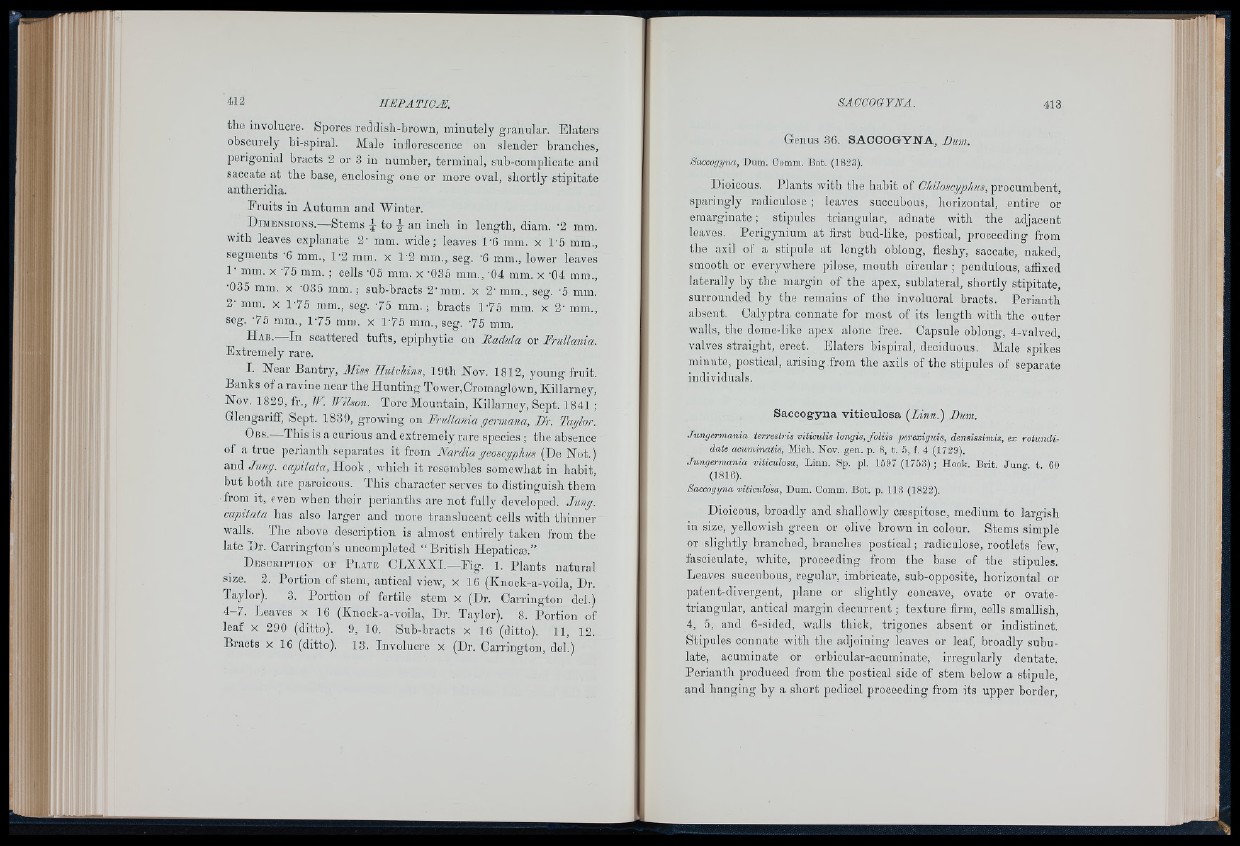
Ill
the involucre. Spores reddish-brown, minutely granular. Elaters
obscurely bi-spiral. Male inflorescence on slender branohes,
perigonial bracts 2 or 3 in number, terminal, sub-ooniplioate and
saccate at the base, enclosing one or more oval, shortly stipitate
antheridia.
Fruits in Autumn and Winter.
D im e n s i o n s .—Stems g to an inch in length, diam. ’2 mm.
with leaves explánate 2' mm. wide; leaves lA mm. x lA mm.,
segments A min., 1'2 min. x 1'2 mm., seg. A mm., lower leaves
!■ mm. x 75 mm. ; cells ’05 mm. x A35 mm., A4 mm. x ’04 mm.,
•035 mm. x -035 mm. ; sub-bracts 2-mm, x 2- mm., seg. -5 mm.
2- mm. X 1-75 mm., seg. -75 mm, ; braots 1-75 mm. x 2- mm,,
seg. -75 mm., 1-75 mm. x 1-75 mm., seg. -75 mm.
H ab .—In scattered tufts, epiphytic on Badda or Fndlania.
Extremely rare.
I. Near Bantry, Miss Hutchins, 19th Nov. 1812, young fruit.
Banks of a ravine near the H unting Tower,Cromaglown, Killarney,
Nov, 1829, fr., W. Wilson. Toro Mountain, Killarney, Sept. 1841 ;
Glengariff, Sept. 1839, growing on Frullania germana. Hr. Taglo-r.
O b s . This is a curious and extremely rare species ; the absence
of a true perianth sejiarates it from Nardia geoscgphns (De Not.)
and Jung, capitaia. Hook , which it resembles somewhat in habit,
but both are paroicous. This character serves to distinguish them
from it, even when their perianths are not fully developed. Jung,
capitata has also larger and more translucent cells with thinner
walls. The above desorijition is almost entirely taken from the
iate Dr, Carrington’s uncompleted “ British Hepaticæ.”
D e s c r i p t i o n o e P l a t e CLXXXI.—Pig. 1. Plants natural
size. 2. Portion of stem, antioal view, x 16 (Kiiock-a-voila, Dr.
Taylor). 3. Portion of fertile stem x (Dr. Carrington deJ.)
4-7. Leaves x 1C (Knock-a-voila, Dr. Taylor). 8. Portion of
leaf X 290 (ditto). 9, 10. Sub-hracts x 16 (ditto). 11, 12.
Braots x 1C (ditto). 13. Involucre x (Dr. Carrington, del.)
Cenus 36. SAGCOGYNA, Bum.
Saccogyna, Dum. Comm. Bot. (1823).
Dioicous. Plants with the habit of Ghiloscgphus, procumbent,
sparingly radiculose ; leaves succubous, horizontal, entire or
emarginate; stipules triangular, adnate with the adjacent
leaves. Perigynium at first bud-like, postieal, proceeding from
tbe axil of a stipule at length oblong, fleshy, saccate, naked,
smooth or everywhere pilose, mouth circular ; pendulous, affixed
laterally by the margin of the apex, sublateral, shortly stipitate,
surrounded by the remains of the involucral bracts. Perianth
absent. Calyptra connate for most of its length with the outer
walls, the dome-like apex alone free. Capsule oblong, 4-valved,
valves straight, erect. Elaters bispiral, deciduous. Male spikes
minute, postical, arising from the axils of the stipules of separate
individuals.
Saocogyna viticulosa (Linn.) Bum.
Junyermania terrestris viticulis longis, fo liis perexiguis, densissimis, ex rotundi-
date acuminatis, Mich. Nov. gen. p. 8, t. 5, f. 4 (1729).
Jungermania viticulosa, Linn. Sp. pi. 1597 (1753) ; Hook. Brit. Ju n g . t. 60
(1816).
Saccogyna viticulosa, Dum, Comm. Bot. p. 113 (1822).
Dioicous, broadly and shallowly cæsjiitose, medium to largish
in size, yellowish green or olive brown in colour. Stems simple
or slightly branched, branches postical; radiculose, rootlets few,
fasciculate, white, proceeding from the base of the stipules.
Leaves succubous, regular, imbricate, sub-opposite, horizontal or
patent-divergent, plane or slightly concave, ovate or ovate-
triangular, antical margin deourrent ; texture firm, cells smallish,
4, 5, and 6-sided, walls thick, trigones absent or indistinct.
Stipules connate with the adjoining leaves or leaf, broadly subulate,
acuminate or orbicular-acuminate, irregularly dentate.
Perianth produced from the postical side of stem below a stipule,
and hanging by a short pedicel proceeding from its upper border,